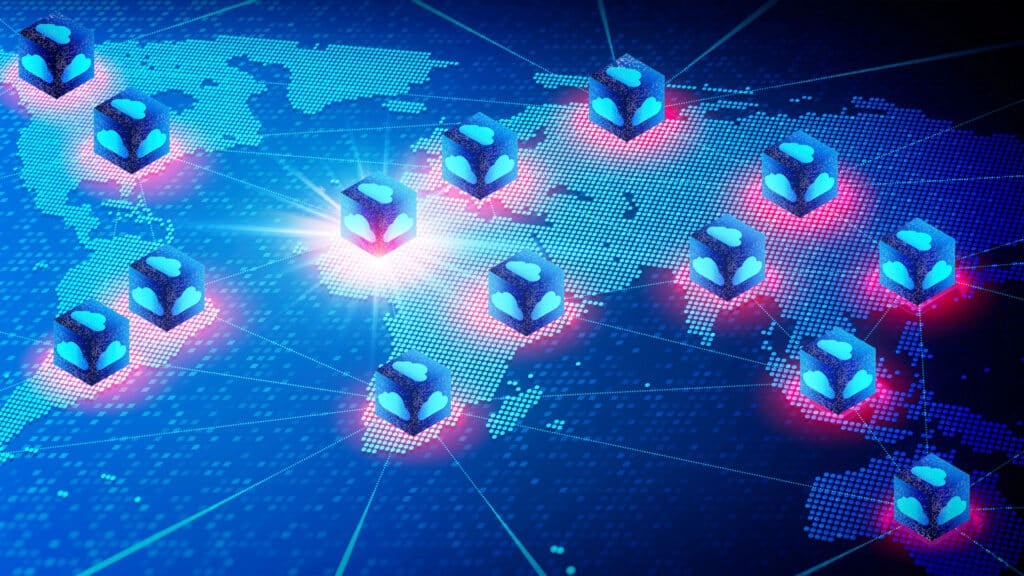On this episode of The Six Five – On The Road, hosts Daniel Newman and Patrick Moorhead welcome Ruth Sun, Global Managing Director from IBM and Prashant Vithlani, Cloud Business Division Head from Samsung SDS America (SDSA) for a conversation at CES 2024 on Samsung SDSA’s collaboration with IBM to transform the cloud space with automation.
Their discussion covers:
- A brief overview of the collaboration between Samsung SDSA and IBM
- How Apptio and Turbonomic are helping to enhance the Samsung Cloud Platform
- What challenges the cloud industry might face in 2024 and how IBM and Samsung SDSA plan on addressing them
Explore more about the growing IBM and Samsung partnership here.
Be sure to subscribe to The Six Five Webcast, so you never miss an episode.
Watch the video here:
Or Listen to the full audio here:
Disclaimer: The Six Five webcast is for information and entertainment purposes only. Over the course of this webcast, we may talk about companies that are publicly traded, and we may even reference that fact and their equity share price, but please do not take anything that we say as a recommendation about what you should do with your investment dollars. We are not investment advisors, and we ask that you do not treat us as such.
Transcript:
Patrick Moorhead: The Six Five is on the road at CES 2024 here in Las Vegas. It has been an incredible event so far. AI, AI, AI and everything, AI PC, AI smartphones, AI gadgets, AI TVs. Dan, that was the talk of this event so far.
Daniel Newman: Yeah, I think it was set up really well. We came into the year. We knew that that was going to be the trend line. It was nice though, by the way, having a week between New Year and CES.
Patrick Moorhead: Right.
Daniel Newman: I don’t know about you, but in the past, that being settled down for a couple of weeks and then having to leave on that Sunday after finally having a couple of days of work and then heading out here.But Pat, it has been a great event. The AI trend line has set up really, really well. But I think it’s not just AI. I think it’s AI and, is the theme here as you’re seeing IoT plus AI, you’re seeing automotive ADAS plus AI, you’re seeing cloud technologies, and I think that’s the big thing is this year it’s going to be about implementation.
Patrick Moorhead: Absolutely. And can’t notice the sphere that I was looking at that had the Samsung content emblazoned all over this, but one of the themes of a lot of the big shows we come to is it takes a village. You have collaborations between companies to get things done. And one of these collaborations is between IBM and Samsung. We chronicled this at Mobile World Congress last year. We did another Six Five video on it, and we are here again, here at CES. I’d like to welcome Ruth, Prashant, welcome to The Six Five.
Prashant Vithlani: Thank you.
Ruth Sun: Thank you for having us.
Patrick Moorhead: Absolutely.
Daniel Newman: We appreciate you taking a little bit of time to sit down and talk to us. We know that there’s work being done together in the cloud space. And maybe just kicking off, Ruth, talk a little bit about what IBM and Samsung America SDS are doing together in that particular area?
Ruth Sun: Yeah, excellent question and a great way to start the discussion. So as you know, IBM has had a over three decade long relationship across all of divisions in Samsung, whether it’s their mobile business, their semiconductor business and beyond. With Samsung SDS, we are pleased to collaborate on a variety of areas. First of all, who is Samsung SDS? Samsung SDS is a global IT services and logistics business operating in over 20 countries around the world. Within the Americas, we collaborate in a variety of areas, and Prashant and I will talk a little bit about this, but regardless of whether it’s in America or globally, we have a collaboration around how to bring to life transformations around cloud, transformations around IT modernization, transformations around exactly what you talked about, AI and delivering value at speed. And if you think about IBM’s capabilities around watsonx and the investments that we’ve made, as well as this associated technology stack of IT operations and FinOps, we’ve really been very excited about the progress that we’ve made together.
Prashant Vithlani: So just add to what Ruth said. So the first thing last year we did was an integration between the Red Hat OpenShift on the Samsung Cloud basically. And now what we’re doing is continuing that path and now looking at our application and modernizing them with OpenShift and Samsung Cloud. So that’s the first initiative that we are working in Americas right now. Second area that we are focusing is the watsonx Generation AI coming on our zero touch mobility solution, which I think it’s already on the way. And the third area that Ruth mentioned about the IT modernization, IT automation side, and that’s where we just signed an agreement around Cloudability and Turbonomics basically. So we’re going to be rolling that out next year. That will help us serve our client basically and increase our service to our clients in America.
Ruth Sun: Actually, this year, because it’s 2024 we’re in.
Prashant Vithlani: This year, sorry. This year.
Patrick Moorhead: That’s right.
Ruth Sun: Like we said.
Daniel Newman: We’re just getting in habit, right?
Ruth Sun: That’s right.
Daniel Newman: The habit of it. I’ve sent at least a few emails that still say ’23 on them.
Patrick Moorhead: I haven’t written my first check yet, but we’ll see. I don’t write a lot of checks, but we’ll see. Let’s do the drill-down into Turbonomic and Apptio and how is it enhancing the Samsung Cloud platform? Maybe some specifics I think would help.
Prashant Vithlani: Yeah, so my focus is America, so all the affiliates are either on the public cloud or Samsung Cloud or their own infrastructure. So we are looking to utilize Apptio and Cloudability from cost management perspective, cost of optimization perspective, and also using Turbonomics from bringing that automation on workload side basically. So these are the two main specific areas I focus on.
Ruth Sun: And if I expand a little bit on what Prashant talked about, the benefits of the FinOps and IT ops capabilities of Apptio and Turbonomics is really providing a single pane of glass to the administrators of a multi-cloud organization that SDS has to manage on a regular basis and making it much more easy to understand what are hotspots that need to be addressed immediately? What are patterns that can drive automation in order to improve quality of service, reduce costs? And then more importantly, provide transparency across, whether it’s on-prem, on Samsung’s cloud, or on any other type of hyperscaler, on AWS and et cetera, so that Prashant and the team can really maximize their time on higher value work.
Patrick Moorhead: Right. Yeah. I’m grinning because I’m a big multi-cloud fan. Started researching it probably a decade before it was cool, okay? But both our companies have written a lot about Apptio and Turbonomics and these two used across the multi-cloud because one thing we know for certain is everybody’s going to have multiple clouds and being able to do cost management, management of the workloads across single pane of glass is critical. And then you add Red Hat as a multi-cloud container across all those places, it starts to get really interesting and what Dan and I call the maturation of the cloud compared to where we were five or six years ago. Sounds like you’ve made some really good progress.
Daniel Newman: So if I can double-click a little bit there, I believe that we’re going to see some significant investment in FinOps, for instance, over the next 12 months. And of course, the Apptio acquisition was a big bet. You also leaned into observability, and that’s really the fire hose of insights that a company provides that everything from security to just app performance and keeping eyes on all those things. But is this driving a partnership? Because one of the things in terms of driving the partnerships that I think is happening is companies are going to spend… Our data says they’re going to be spending about three times as much on deployments of AI this year as they did last year. Everyone talked about last year being the AI year, but it was really the GPU year. This year is the actual implementation year.
Ruth Sun: Right.
Daniel Newman: And so FinOps is going to be important because companies are going to try to figure out, “Finally, we’ve made all these commitments to cloud spend, but how do we actually manage that?” And then redirect, because I also hear IT budgets aren’t actually up that much. We’re still in this austerity period. How do these things all come together? And Prashant, I’ll let you take this first, but how do these things come together to really help you enable customers to take off with their AI strategies and plans and continue to implement, manage, and deal with all the complexity of cloud?
Prashant Vithlani: That’s a big question.
Daniel Newman: That’s great. Yeah, it’s a good one.
Prashant Vithlani: Yes, it is. No, I’m going to think of this one team, so give me a second.
Ruth Sun: Yeah, actually, let me add some thoughts here while Prashant… Prashant knows this stuff so well, right? So, so well. Actually, his name is Deep, right? So his ability to digest at scale is incredible. But your point around AI delivering value, but being able to do that in a heterogeneous environment that’s multi-cloud, and creating that single pane of glass that allows organizations to optimize efficiency from the capabilities that we’ve acquired between Apptio and Turbonomics. And then the collaboration to your question is how does this become a partnership? The collaboration with Samsung’s best-in-class capabilities in running IT operations for their affiliate companies or for non-affiliate companies in the United States, as well as being able to dynamically adjust capabilities across workloads based on business demands and needs, right?
You talked about IT, budgets not being up. That is absolutely correct. And if anything, organizations need to be able to dynamically adjust as business needs adjust, but you can’t forklift infrastructure from here to there immediately. And that’s the beauty of the software layer around the FinOps and IT ops capabilities of Apptio and Turbonomics. My humble opinion. I don’t know, you want to correct me?
Prashant Vithlani: No, I agree with you. I think also I’ll just add that environment is quite complex for us. There’s so many affiliates, different, different IT budgets. And what we are trying to do with Turbo and Apptio is to consolidate altogether under one single plane and be able to allocate resources and spend across and be able to generate that saving across all the affiliates, basically. So that’s the focus.
Patrick Moorhead: So I’d love to wrap this with looking forward ahead to the year. I know FinOps and management are part of it, but the cloud is a teenager, right? It’s 14, 15 years old, depending on where you think it started. And we’ve just enabled these multi-cloud… I’ll call them fabrics, whether they’re app fabrics, networking, security FinOps. Where are you focused in 2020? What are the challenges in 2024 that you’re trying to get underneath and knock out?
Prashant Vithlani: Well, I think I mentioned earlier that we have so many affiliates that brings a lot of complexity to us.
Patrick Moorhead: When you say affiliates, do you mean BUs and BUs inside of BUs?
Prashant Vithlani: Yeah, BUs within the BUs. We have different divisions and stuff like that. They all have their own budgets and they all manage those across for IT automation, IT environment, stuff like that. So what we have to do is from an SDS, we bring all these together and we basically be able to generate savings for them. And this is the complex environment because now we are talking to so many different stakeholders and bringing what they’re trying to do, understand what they’re trying to bring next to the market next year. Right now we are more on the reactive side with this. Now we want to be part of that from the beginning, so we can help them with Apptio and Turbo, is to be able to do that design from the day one, basically. So those are some of the things that we will be starting this year, and that’s why it was very important for us to get going last year. So this year is just we ramp up with those two tools, basically.
Patrick Moorhead: Yeah, it made a lot of progress. Again, Red Hat, multi-cloud fabrics, Apptio, Turbonomics, multi-cloud fabrics in a different way. And that is the rage, right? Because on one hand, you don’t want to increase complexity by adding cloud partners, but the challenge is it comes to you, right?
Prashant Vithlani: Yeah.
Patrick Moorhead: Where, “Oh, this somebody has a special way to do something on AI, or you need a sovereign cloud somewhere.” It perpetuates that. So a lot of progress.
Ruth Sun: If I add to what you just said and what Prashant just articulated, the initial approach that we took last year was how do we reactively address this complexity?
Patrick Moorhead: Yes.
Ruth Sun: And as SDS explored the market and scanned the market for best-in-class capabilities that were again, agile, adaptable, provide that single plane of class, we were able to address an immediate pain point last year. Prashant did an excellent job talking about in 2024 and going forward, we’re moving from reactive to being proactive, right?
Patrick Moorhead: Yes. Strategic.
Ruth Sun: Yes, yes. And then also being strategic in our approach so that it’s not fixing and addressing a need for just one business unit or affiliate or division within Samsung companies, but being able to again, write once, deploy anywhere, be seamless in our operations, and then optimize efficiency across the business. So we are absolutely thrilled about the progress that we’ve started and the journey that we started, but more importantly, what we will achieve in 2024.
Patrick Moorhead: Excellent.
Daniel Newman: Prashant, Ruth, I want to thank you so much for joining us here on The Six Five.
Ruth Sun: Thank you.
Prashant Vithlani: Thank you.
Patrick Moorhead: Thanks.
Daniel Newman: All right, everybody. Hit that subscribe button, join us for all of our episodes of The Six Five. We’re here at CES 2024 in Las Vegas. Appreciate you tuning in. For now, from Patrick, from myself, got to say goodbye. See you all later.
Author Information
Daniel is the CEO of The Futurum Group. Living his life at the intersection of people and technology, Daniel works with the world’s largest technology brands exploring Digital Transformation and how it is influencing the enterprise.
From the leading edge of AI to global technology policy, Daniel makes the connections between business, people and tech that are required for companies to benefit most from their technology investments. Daniel is a top 5 globally ranked industry analyst and his ideas are regularly cited or shared in television appearances by CNBC, Bloomberg, Wall Street Journal and hundreds of other sites around the world.
A 7x Best-Selling Author including his most recent book “Human/Machine.” Daniel is also a Forbes and MarketWatch (Dow Jones) contributor.
An MBA and Former Graduate Adjunct Faculty, Daniel is an Austin Texas transplant after 40 years in Chicago. His speaking takes him around the world each year as he shares his vision of the role technology will play in our future.









